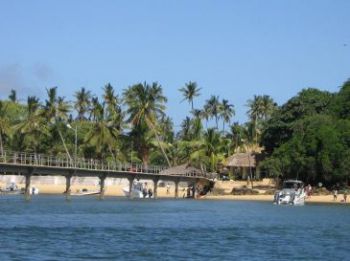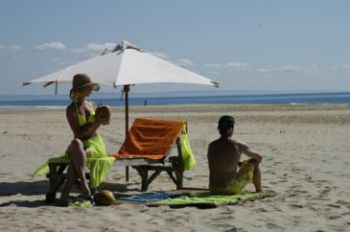Attractions

Bazaruto Archipelago
The most popular tourist area in Mozambique, includes the four main islands in the Inhambane province - Magarruque, Benguerra, Santa Corolina and Bazaruto. They are situated some 35Km off the mainland and are accessible by boat, or small aircraft, from the town of Vilanculos.
High quality accommodation attracts international visitors who, as well as swimming and sunbathing, can take part in numbers of outdoors activities and a full range of water-sports that includes snorkelling, scuba diving, deep-sea fishing, sailing and water-skiing. Small antelope roam the islands, alongside fresh-water crocodiles, mangrove crabs and samango monkeys while flamingo nest on the fresh water lakes.
The islands are in fact home to over 240 varieties of birds including fish eagles ,bee-eaters , harriers, ospreys and the elusive crab plover and green coucal. Bazaruto Marina Park now covers the entire Bazaruto Archipelago making this 1400 sq km reserve one of the largest in the Ocean. In addition to humpback whales dolphins, manta rays and five species of turtle, some 100 dugongs survive here- one of the very few viable populations on the East African c coast
Inhaca
About 34KM out into Maputo Bay, Inhaca Island offers many different activities including a tractor ride to the lighthouse or a visit to the Marine Biology Museum. Scuba diving, snorkelling, kayaking, parasailing , windsurfing and surf or deep-sea fishing is just some of the exciting activities.
An excursion to neighbouring Portuguese Island or an escape to the “wild-side” of the island-with its crashing surf, deep ,blue sea and glorious wind- are also recommended. The abundant wildlife includes flamingo, pelicans and loggerhead turtles.

The Beaches
All the coastal provides boast superb beaches some of the best of which are listed in other places to visit. Here are some of the beaches:
Beaches of Quirimbas islands
Beaches of Bazaruto islands
Praia do Wimbi, in Pemba
Praia das Chocas Mar, around Mozambique Island, in Nampula Province
Praia de Angoche
Praia de Zalala, in Quelimane
Paraia de Pebane, in Zambezia Province
Praia do Tofo, Praia de Paindane, Praia de Jangamo, Praia de Morrungulo, Praia da Barra, Praia de Vilanculo – all of them in Inhambane Province
Praia de Xai-Xai, Praia do Bilene, Praia de Zonguene, Praia de Chidenguele – all of them in Gaza Province
Praia da Ponta D’Ouro, Praia da Macaneta – in Maputo Province
Praia da Costa do Sol, Praia da Catembe – in Maputo CityTransfrontrier Parks … And Other Safari Options
Mozambique’s National parks are being re-stocked through an ongoing wildlife relocation programme. This will see some 6,000 animals, including elephant, giraffe, hippo, rhino and Zebra, relocated from South Africa, Botswana and other neighbouring countries
The most exciting development however is the cross-border wildlife reserve know as Tran frontier Parks. Large tracts of land in Mozambique are included in two of these projects.
The first links the Limpopo National Park with the Kruger, in South Africa, and Gonarezhou in Zimbabwe, to create a protected wilderness area of 35,000 sq km. Both the Kruger and Gonarezhou are rich in wildlife and the removal of border fences allows game to move from these parks into Mozambique.
The second Tran frontier Park will link Mozambique’s Maputo Elephant Reserve with South Africa’s Tembe Elephant Park to create a major elephant stronghold along Africa’s eastern Coast.
Other well-known wildlife areas in Mozambique are the Banhine (Gaza), Gorongosa (Sofala) and Zinave (Inhambane)National Parks and Gile (Zambezia), Marromeu (Sofala), Niasa (Niassa), and Pomene (Inhambane) Games Reserves.<palign="justify">Photos Source - Barra Lodge Beach Resort promotion CD
Mozambique Island
The Ilha de Mocambique (Mozambique Island) also named by natives as Muhipite is a world heritage site. It represents a remark of a world civilizations testimony in the east Africa. It served as first capital city of the country and was a very important point for maritime trade.
Quirimbas Archipelago
Consisting of 32 coral islands, including the beautiful Ibo Island, and stretching from Pemba to the Rovuma River on the border with Tanzania, the area is slowly being developed as an exclusive tourist paradise. There is ample opportunity for relaxation while scuba diving, snorkelling, deep-sea-fishing, sailing, surf-casting and bird watching are just some of the activities on offer. The southern most of the islands, and a vast expanse of mainland forest, from the recently declared Quirimbas National Park.
Elephants, leopards, lion, buffalo, wild dog and an amazing bird life may be seen here while the marine fauna and flora includes sharks, sea turtles; humpback whales the occasional dugong and over types of coral.


